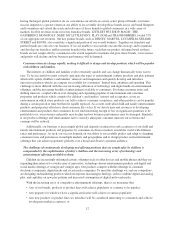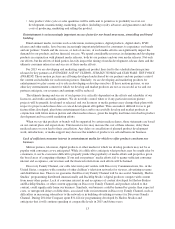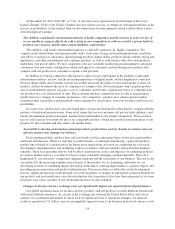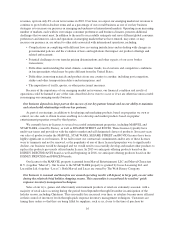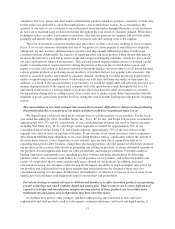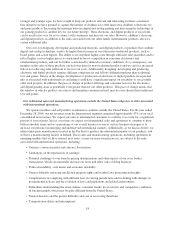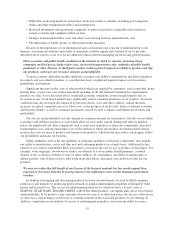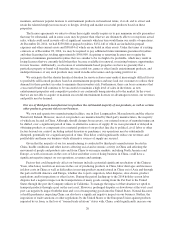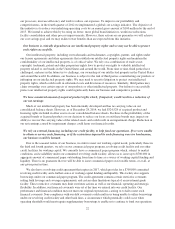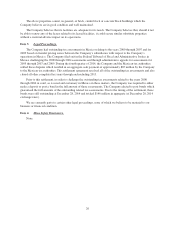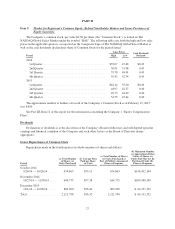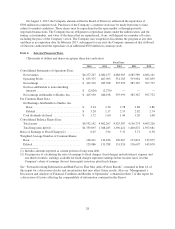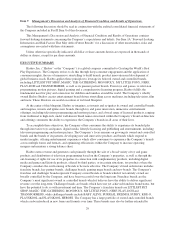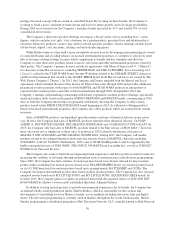Hasbro 2014 Annual Report Download - page 36
Download and view the complete annual report
Please find page 36 of the 2014 Hasbro annual report below. You can navigate through the pages in the report by either clicking on the pages listed below, or by using the keyword search tool below to find specific information within the annual report.our processes, increase efficiency and work to reduce our expenses. To improve our profitability and
competitiveness, in the fourth quarter of 2012 we implemented a global cost savings initiative. The objective of
this initiative is to reduce our underlying operating costs by an annual gross amount of $100 million by the end of
2015. We intend to achieve this by focusing on fewer, more global brand initiatives, workforce reductions,
facility consolidation and other process improvements. However, these actions are no guarantee we will achieve
our cost savings goal and we may realize fewer benefits than are expected from this initiative.
Our business is critically dependent on our intellectual property rights and we may not be able to protect
such rights successfully.
Our intellectual property, including our trademarks and tradenames, copyrights, patents, and rights under
our license agreements and other agreements that establish our intellectual property rights and maintain the
confidentiality of our intellectual property, is of critical value. We rely on a combination of trade secret,
copyright, trademark, patent and other proprietary rights laws to protect our rights to valuable intellectual
property related to our brands in the United States and around the world. From time to time, third parties have
challenged, and may in the future try to challenge, our ownership of our intellectual property in the United States
and around the world. In addition, our business is subject to the risk of third parties counterfeiting our products or
infringing on our intellectual property rights. We may need to resort to litigation to protect our intellectual
property rights, which could result in substantial costs and diversion of resources. Similarly, third parties may
claim ownership over certain aspects of our products or other intellectual property. Our failure to successfully
protect our intellectual property rights could significantly harm our business and competitive position.
We have a material amount of acquired product rights which, if impaired, would result in a reduction of
our net earnings.
Much of our intellectual property has been internally developed and has no carrying value on our
consolidated balance sheets. However, as of December 28, 2014, we had $324,528 of acquired product and
licensing rights included in other assets on our consolidated balance sheets. Declines in the profitability of the
acquired brands or licensed products or our decision to reduce our focus or exit these brands may impact our
ability to recover the carrying value of the related assets and could result in an impairment charge. Reduction in
our net earnings caused by impairment charges could harm our financial results.
We rely on external financing, including our credit facility, to help fund our operations. If we were unable
to obtain or service such financing, or if the restrictions imposed by such financing were too burdensome,
our business would be harmed.
Due to the seasonal nature of our business, in order to meet our working capital needs, particularly those in
the third and fourth quarters, we rely on our commercial paper program, revolving credit facility and our other
credit facilities for working capital. We currently have a commercial paper program which, subject to market
conditions, and availability under our committed revolving credit facility, allows us to issue up to $700,000 in
aggregate amount of commercial paper outstanding from time to time as a source of working capital funding and
liquidity. There is no guarantee that we will be able to issue commercial paper on favorable terms, or at all, at
any given point in time.
We also have a revolving credit agreement that expires in 2017, which provides for a $700,000 committed
revolving credit facility and a further source of working capital funding and liquidity. This facility also supports
borrowings under our commercial paper program. The credit agreement contains certain restrictive covenants
setting forth leverage and coverage requirements, and certain other limitations typical of an investment grade
facility. These restrictive covenants may limit our future actions as well as our financial, operating and strategic
flexibility. In addition, our financial covenants were set at the time we entered into our credit facility. Our
performance and financial condition may not meet our original expectations, causing us to fail to meet such
financial covenants. Non-compliance with our debt covenants could result in us being unable to utilize borrowings
under our revolving credit facility and other bank lines, a circumstance which potentially could occur when
operating shortfalls would most require supplementary borrowings to enable us to continue to fund our operations.
22


